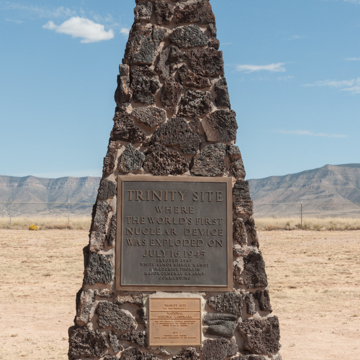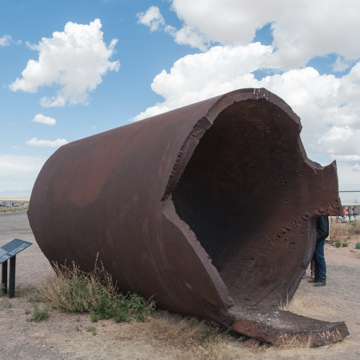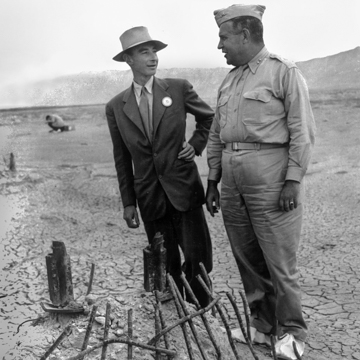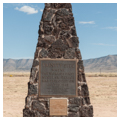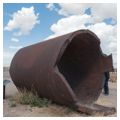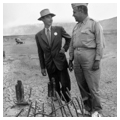Ground Zero has been altered multiple times since the nuclear explosion on July 16, 1945, created a crater 8-10 feet deep and a half-mile across.
In 1946, the crater was enclosed by chain link fencing. In 1952, the crater was bulldozed to remove the radioactive trinitite, except for a small area preserved under a low shelter that stands to this day. In 1965, an obelisk of lava stone was erected at the hypocenter of Ground Zero, next to the visible remains of one of the four original footings for the 100-foot tower. Its plaque reads: “Trinity Site, where the world’s first nuclear device was exploded on July 16, 1945. White Sands Missile Range; J. Frederick Thorlin, Major General, U.S. Army Commanding.” That same year, Trinity Site was designated a National Historic Landmark. In 1967, the inner portion of Ground Zero was enclosed by an oblong chain link fence, which was connected in 1972 by a barbed-wire access corridor to the outer perimeter fence.
The stump of a steel container nicknamed Jumbo rests just outside the entrance to Ground Zero. With steel walls 15 inches thick (6 inches of steel plate and 9 inches of steel banding), this cylinder originally had rounded ends, measured 25 feet in length and 12 feet in diameter, and weighed 214 tons. Jumbo was made on orders of General Leslie Groves; if the atomic bomb was a “fizzle,” i.e., if its high explosive lenses detonated but failed to initiate nuclear fission, he wanted a device to contain the explosion and capture the plutonium for reuse.
Designed by the engineer Roy Carlson and fabricated by the Babcock and Wilcox Steel Corporation of Baberton, Ohio, Jumbo was transported with great difficulty on a modified 200-ton railway flatcar and then on a 64-wheel trailer truck, reaching Trinity Site in early April 1945. The Los Alamos scientists, however, had always been skeptical of its utility and, as their confidence in the atomic bomb’s reliability grew, Robert Oppenheimer and Kenneth Bainbridge decided that Jumbo was not needed. This proved wise because, besides throwing off measurements of the blast, its use would have contributed 214 tons of radioactive steel particles to the nuclear explosion. Instead, Jumbo was set upright in a 70-foot steel tower, 800 yards from Ground Zero, where it survived the nuclear blast intact. In 1946, the U.S. Army stacked eight 500-pound bombs at its bottom, which blew off the two ends without destroying the central cylinder. Jumbo was moved to its present location in 1979.
First opened to the public in 1953, Trinity Site can be visited twice a year on the first Saturday in April and October.
References
DeGroot, Gerald J. The Bomb: A Life. Cambridge, MA: Harvard University Press, 2005.
Greenwood, Richard, “Trinity Site,” Socorro County, New Mexico. National Register of Historic Places Registration Form, 1975. National Park Service, U.S. Department of the Interior, Washington, D.C.
Rhodes, Richard. The Making of the Atomic Bomb. New York: Simon and Schuster, 1986.
Seeber, Robert. The Los Alamos Primer: The First Lectures on How to Build An Atomic Bomb. Edited and introduction by Richard Rhodes. Berkeley: University of California, 1992.
Szasz, Ferenc Morton. The Day the Sun Rose Twice: The Story of the Trinity Site Nuclear Explosion July 16, 1945. Albuquerque: University of New Mexico, 1984.












